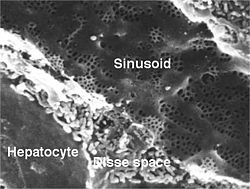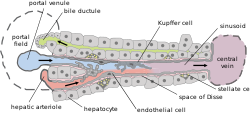肝血竇
外觀
| 肝血竇 | |
|---|---|
 | |
 Basic liver structure | |
| 標識字符 | |
| 拉丁文 | vas sinusoideum |
| TH | H3.04.05.0.00014 |
| FMA | FMA:17543 |
| 《解剖學術語》 [在維基數據上編輯] | |
肝血竇(英語:Liver sinusoid或Hepatic sinusoids)是一種被稱為竇狀毛細血管、不連續毛細血管或血竇的毛細血管。它類似於有孔毛細血管,具有不連續的內皮細胞,可作為來自肝總動脈的富氧血液和來自肝門靜脈的富營養血液的混合位置。[1]
肝血竇具有比其他類型的毛細血管更大的口徑,並具有稱為肝竇內皮細胞(LSEC)和庫普弗細胞的特化內皮細胞襯裡。[2]這些細胞是多孔的並且具有清除功能。[3]LSEC約占肝臟中非實質細胞的一半,扁平且有孔,[4]可以使竇腔和竇周間隙之間更容易交流。LSEC和庫普弗細胞在過濾、胞吞作用和調節血竇中的血流方面發揮作用。[5]
庫普弗細胞可以吞食外來物質,例如細菌。竇周間隙將肝細胞與血竇分開。肝臟星狀細胞存在於竇周間隙中,並參與對肝臟的纖維化反應。
當LSEC丟失使竇道成為一個普通的毛細血管時,就會發生剝落現象。這一過程先於纖維化發生。[6]
內皮細胞
[編輯]肝血竇內皮細胞可用於各種研究目的。這些細胞的效用特別令人感興趣。只是要克服它的一個問題,那就是細胞分化的逆轉。這種逆轉使這些細胞在體外表型上高度特化。[7]
圖像
[編輯]-
人類肝血竇
-
豬肝臟的單個小葉
參考文獻
[編輯]- ^ SIU SOM Histology GI. [2023-01-28]. (原始內容存檔於2017-07-17).
- ^ Brunt, EM; et al. Pathology of the liver sinusoids.. Histopathology. June 2014, 64 (7): 907–20. PMID 24393125. S2CID 12709169. doi:10.1111/his.12364.
- ^ DeLeve, LD. Hepatic microvasculature in liver injury.. Seminars in Liver Disease. November 2007, 27 (4): 390–400. PMID 17979075. doi:10.1055/s-2007-991515.
- ^ Xing, Y; Zhao, T; Gao, X; Wu, Y. Liver X receptor α is essential for the capillarization of liver sinusoidal endothelial cells in liver injury.. Scientific Reports. 18 February 2016, 6: 21309. Bibcode:2016NatSR...621309X. PMC 4758044
 . PMID 26887957. doi:10.1038/srep21309.
. PMID 26887957. doi:10.1038/srep21309.
- ^ Arii, S; Imamura, M. Physiological role of sinusoidal endothelial cells and Kupffer cells and their implication in the pathogenesis of liver injury.. Journal of Hepato-biliary-pancreatic Surgery. 2000, 7 (1): 40–8. PMID 10982590. doi:10.1007/s005340050152.
- ^ Xie, G; Wang, X; Wang, L; Wang, L; Atkinson, RD; Kanel, GC; Gaarde, WA; Deleve, LD. Role of differentiation of liver sinusoidal endothelial cells in progression and regression of hepatic fibrosis in rats.. Gastroenterology. April 2012, 142 (4): 918–927.e6. PMC 3618963
 . PMID 22178212. doi:10.1053/j.gastro.2011.12.017.
. PMID 22178212. doi:10.1053/j.gastro.2011.12.017.
- ^ Sellaro TL, Ravindra AK, Stolz DB, Badylak SF. Maintenance of hepatic sinusoidal endothelial cell phenotype in vitro using organ-specific extracellular matrix scaffolds. Tissue Eng. September 2007, 13 (9): 2301–2310 [28 April 2013]. PMID 17561801. doi:10.1089/ten.2006.0437.
外部連結
[編輯]- UIUC組織學主題 589
- Histology image: 15504loa – 波士頓大學的組織學學習系統 - "Liver, Gall Bladder, and Pancreas: liver, classic lobule"
- Histology image: 22103loa – 波士頓大學的組織學學習系統 - "Ultrastructure of the Cell: hepatocytes and sinusoids, sinusoid and space of Disse"
- Histology at anhb.uwa.edu.au (頁面存檔備份,存於網際網路檔案館)


